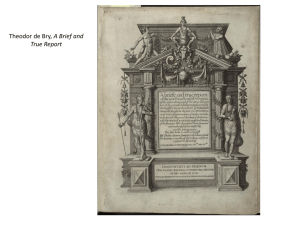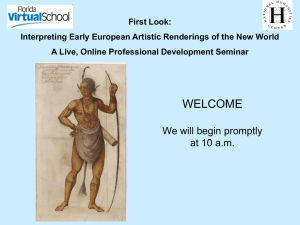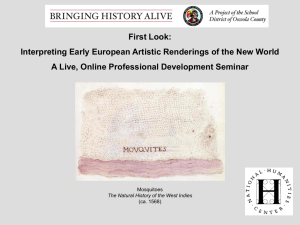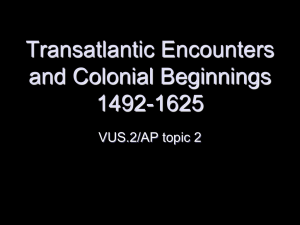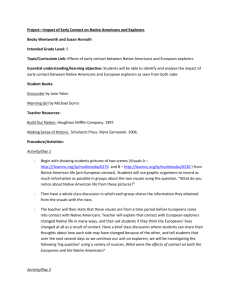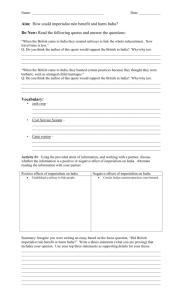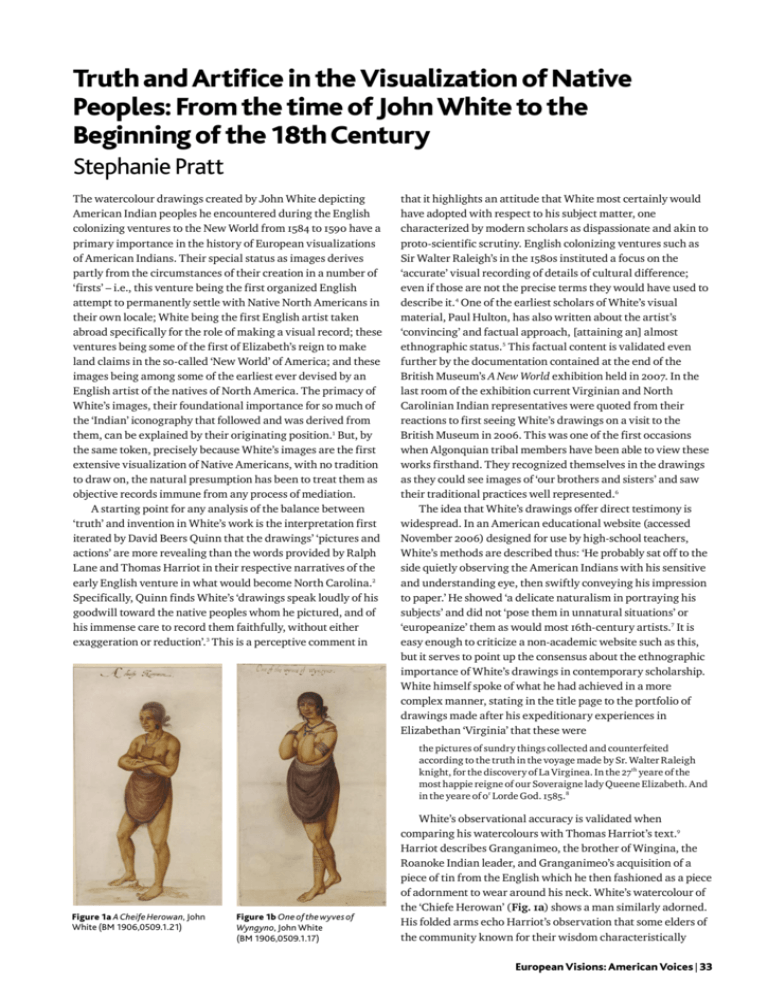
Truth and Artifice in the Visualization of Native
Peoples: From the time of John White to the
Beginning of the 18th Century
Stephanie Pratt
The watercolour drawings created by John White depicting
American Indian peoples he encountered during the English
colonizing ventures to the New World from 1584 to 1590 have a
primary importance in the history of European visualizations
of American Indians. Their special status as images derives
partly from the circumstances of their creation in a number of
‘firsts’ – i.e., this venture being the first organized English
attempt to permanently settle with Native North Americans in
their own locale; White being the first English artist taken
abroad specifically for the role of making a visual record; these
ventures being some of the first of Elizabeth’s reign to make
land claims in the so-called ‘New World’ of America; and these
images being among some of the earliest ever devised by an
English artist of the natives of North America. The primacy of
White’s images, their foundational importance for so much of
the ‘Indian’ iconography that followed and was derived from
them, can be explained by their originating position.1 But, by
the same token, precisely because White’s images are the first
extensive visualization of Native Americans, with no tradition
to draw on, the natural presumption has been to treat them as
objective records immune from any process of mediation.
A starting point for any analysis of the balance between
‘truth’ and invention in White’s work is the interpretation first
iterated by David Beers Quinn that the drawings’ ‘pictures and
actions’ are more revealing than the words provided by Ralph
Lane and Thomas Harriot in their respective narratives of the
early English venture in what would become North Carolina.2
Specifically, Quinn finds White’s ‘drawings speak loudly of his
goodwill toward the native peoples whom he pictured, and of
his immense care to record them faithfully, without either
exaggeration or reduction’.3 This is a perceptive comment in
that it highlights an attitude that White most certainly would
have adopted with respect to his subject matter, one
characterized by modern scholars as dispassionate and akin to
proto-scientific scrutiny. English colonizing ventures such as
Sir Walter Raleigh’s in the 1580s instituted a focus on the
‘accurate’ visual recording of details of cultural difference;
even if those are not the precise terms they would have used to
describe it.4 One of the earliest scholars of White’s visual
material, Paul Hulton, has also written about the artist’s
‘convincing’ and factual approach, [attaining an] almost
ethnographic status.5 This factual content is validated even
further by the documentation contained at the end of the
British Museum’s A New World exhibition held in 2007. In the
last room of the exhibition current Virginian and North
Carolinian Indian representatives were quoted from their
reactions to first seeing White’s drawings on a visit to the
British Museum in 2006. This was one of the first occasions
when Algonquian tribal members have been able to view these
works firsthand. They recognized themselves in the drawings
as they could see images of ‘our brothers and sisters’ and saw
their traditional practices well represented.6
The idea that White’s drawings offer direct testimony is
widespread. In an American educational website (accessed
November 2006) designed for use by high-school teachers,
White’s methods are described thus: ‘He probably sat off to the
side quietly observing the American Indians with his sensitive
and understanding eye, then swiftly conveying his impression
to paper.’ He showed ‘a delicate naturalism in portraying his
subjects’ and did not ‘pose them in unnatural situations’ or
‘europeanize’ them as would most 16th-century artists.7 It is
easy enough to criticize a non-academic website such as this,
but it serves to point up the consensus about the ethnographic
importance of White’s drawings in contemporary scholarship.
White himself spoke of what he had achieved in a more
complex manner, stating in the title page to the portfolio of
drawings made after his expeditionary experiences in
Elizabethan ‘Virginia’ that these were
the pictures of sundry things collected and counterfeited
according to the truth in the voyage made by Sr. Walter Raleigh
knight, for the discovery of La Virginea. In the 27th yeare of the
most happie reigne of our Soveraigne lady Queene Elizabeth. And
in the yeare of or Lorde God. 1585.8
Figure 1a A Cheife Herowan, John
White (BM 1906,0509.1.21)
Figure 1b One of the wyves of
Wyngyno, John White
(BM 1906,0509.1.17)
White’s observational accuracy is validated when
comparing his watercolours with Thomas Harriot’s text.9
Harriot describes Granganimeo, the brother of Wingina, the
Roanoke Indian leader, and Granganimeo’s acquisition of a
piece of tin from the English which he then fashioned as a piece
of adornment to wear around his neck. White’s watercolour of
the ‘Chiefe Herowan’ (Fig. 1a) shows a man similarly adorned.
His folded arms echo Harriot’s observation that some elders of
the community known for their wisdom characteristically
European Visions: American Voices | 33
Pratt
adopted such a pose.10
John White’s ‘truth’, however, is not now easily mapped
onto our current expectations of naturalism in art and the
mechanical recording of space, volume, shape, colour, field and
depth as we understand these elements today. His concepts of
truth and artifice pertained to his practice as a gentlemanlimner in the tradition instituted by Nicholas Hilliard.11
The limning tradition was codified in several art treatises
in English published towards the end of the 16th and beginning
of the 17th centuries, just following the period when White was
most active as an ethnographer/artist. Richard Haydocke’s
translation of Lomazzo’s Trattato (first published in Italian in
1583) appeared in 1598 and continued the incorporation of
Italian Renaissance and Mannerist art theories into the
broader academic professionalization of artists in England.
Nicholas Hilliard’s The Arte of Limning (1600), written at the
request of Haydocke, helped to distinguish limning from other
kinds of painting. Its discussion of the painting of faces is
instructive for my account as one finds a close approximation
to what John White might have considered one of the kinds of
‘truth’ being counterfeited in his art.
But of all things, the perfection is to imitate the face of mankind (or
the hardest part of it, and which indeed one should not attempt
until he were meetly good in story work) so near and so well after
the life as that not only the party in all likeness for favour and
complexion is, or may be, very well resembled, but even his best
graces and countenance notably expressed; for there is no person
but hath variety of looks and countenance, as well ill-becoming as
pleasing or delighting.12
Hilliard’s tract, and indeed White’s practice, promotes the
rendering of faces as a key part of the imaging process, but
rather than record the precise features seen before the artist, a
countenance is best expressed through the perfect resembling
of the ‘best graces’ selecting from a variety of moods or
countenances that the person adopts.
Turning to John White’s single or paired figures of
Algonquian peoples (10 watercolours in total) we find that the
attention to truth in his work is most assuredly found in the
painting of the faces of his figures, who many have noted are
distinctly American Indian in countenance and ‘individualized’
to a large extent. The faces of his Indian figures reveal a certain
amount of variety, as he turns from painting the old to the very
young, a mother and her daughter, ‘age of 8 or 10 yeares’, both
of the village of Pomeiooc (Fig. 2). Further examination of the
Figure 2 A Cheife Herowans wyfe of
Pomeiooc and her daughter, John
White (BM 1906.0509.1.13)
Figure 3 Wyve of Wyngyno (left, detail of Fig 1b) and A Cheife Herowans wyfe
(right, detail of Fig. 2)
faces also reveals the artifice involved in making the ‘best
graces and countenance’ for the kind of portrait being
assembled. White’s painting of the mother of the young
daughter of Pomeiooc and his image of the ‘wyfe’ of Wingina
are facially, and in the arrangement of their hair, very much
the same individual physiognomically (Fig. 3, details).
However, in their depicted poses, costumes and body
decoration, each are distinctive. Are we meant to see them as
the same individual or do their poses, tattooed limbs and
differing titles mean that they are separate and distinct?
White’s male figures are all facially very similar, with the
upturned and rather square chin, full lips, somewhat close-set
eyes and a certain amount of hairstyle repetition (Fig. 4,
details). These figures, apart from their written titles and
differing poses and costumes, are mainly distinguished by
their age, the older figures having much more lined features,
heavily inscribed with dark parallel marks across the forehead
and cheeks. Significantly, White’s images of Florida peoples, a
man and a woman, are facially different from the ‘Virginians’
as they were copies after those made by Jacques Le Moyne.
Here, again, we might have recourse to Renaissance theories of
decorum as instituted in several Italian treatises and
reproduced for an English audience via Haydocke’s translation
of Lomazzo. Younger individuals would show more decoro or
decorum in active poses and older figures would maintain
more reticent and senatorial stances as befitted their stations in
society. Similarly, their faces must show decorum in
expression.
When we turn to the poses, stances, articulation of the
hands and fingers of the Algonquians being represented, we
reach now a place of absolute artifice in John White’s images,
several scholars noting the clear dependence of White and his
Figure 4 A Cheife Herowan (left, detail of Fig 5a), The Flyer (right,) (BM
1906,0509.1.16)
34 |European Visions: American Voices
Truth and Artifice in the Visualization of Native Peoples
Figure 5a Their manner of their attire
and painting themselves, John White,
(BM 1906,0509.1.12)
engraver de Bry on Mannerist forms of expression.13 One wellknown instance of this formulation is the deployment of what
is termed the ‘Renaissance elbow’ in John White’s figure of the
werowance or chief ‘Lorde’, showing the ‘manner of their attire
and painting themselves when they go to their generall
huntings or at theire solemne feasts’.14 He isn’t shown as a
particularly elderly individual and his pose certainly signifies
someone fit and active in European iconographical terms, a
military standard-bearer or young courtier.15 This pose
amounts to an idealization and Europeanization of the original
sitter and begins a process of hybridical representations of
American Indian leaders that lasted far into the 18th century
(Fig. 5a,5b – compare with Standard bearer by H. Goltzius).
Other forms of artifice that enter into John White’s imaging
processes are taken again from Mannerist visual culture, in the
form of engravings, both of whole figures and of smaller
details, such as the depiction of hands and toes. Some of
White’s figures seem to speak through their hands, especially
in the image of the mother and daughter of Pomeiooc, who
Joyce Chaplin and others, have read accurately as literally
drawing in the English viewer to imagine their impact on
American Indian society whose needs are to be fulfilled by the
colonizing effort (see Fig. 2).16 The mother’s right arm and
pointing finger in this watercolour-drawing look very similar
to the right arm in the image of a woman holding a plantain
leaf illustrated in volume 3 of Giambattista Ramusio’s
collection of Navigationi e Viaggi published in Venice in
1550–59. In the circle around Sir Walter Raleigh, Thomas
Harriot, the Hakluyts or the aristocratic patron himself would
have been aware of this important set of published voyages and
offered them to White as further stimulus for his own work.17
Finally, White’s deployment of contemporary visual models is
demonstrated in the distinctive pose of the figure of ‘The flyer’
or medicine person, widely thought to be based on small
bronze reproductions of Giambologna’s sculpted figure of
Mercury of the 1580s, another instance where accepted forms
of European art expression provide appropriate models for the
truths that White wishes to express.18
I would like to make a brief observation at this point about
a source White does not appear to have used, despite having
every possibility of doing so. Manteo and Wanchese were
captured during the first Virginia expedition sponsored by
Raleigh and taken back to England in 1584. While Wanchese
Figure 5b A Standard bearer,
Hendrick Goltzius, 1587, engraving
(BM 1853,1008.87)
only spent those few months of 1584 and 1585 in the company of
the English, Manteo stayed much longer in Raleigh’s household
and amongst his retinue of gentlemen and ‘scientists’ before
finally returning home permanently to the Carolina Outer
Banks, in 1587.19 A traveller’s diary of 1584–85, notes that the
two American Indian men in Raleigh’s company ‘are clad in a
brown taffeta,’ that ‘their faces as well as their whole bodies
were very similar to those of the white Moors at home’;
however, ‘they wear no shirts, only a piece of fur to cover their
pudenda and the skins of wild animals to cover their shoulders.
Nobody could understand their language, and they had a very
childish and wild appearance.’20 There is no evidence that
either man sat for White. Did he view these two captives and
cultural interlopers as non-Anglo but also non-native? Had
Manteo’s excellence as an intermediary meant that his success
in acculturation is now our ethnographic loss?21
What I hope I have suggested in this discussion is that while
White’s images are original and accurate in parts, they contain
a certain amount of invention and artifice relevant to the era in
which they were created. As I now turn to the images that
Theodor de Bry and his workshop created after the John White
watercolours, I hope to show that these also partake in the
visual culture of their creators. Therefore, if White’s images
were only partial truths, de Bry’s copies are removed even
further from the truth. De Bry would have worked faithfully
towards the perfection of his art and would not have
questioned White’s authority as artist on a voyage of
colonization.
His manipulation of John White’s watercolours, their
transformation into graphic imagery, with additions and
inventions of de Bry’s own making, should be understood as
accepted practices of the processes of reproduction. De Bry
enhanced images that he might have considered proto-designs,
prepared for printing but not to be widely disseminated
without further elaboration. The distinction traditionally held
between the two forms of representation is that in John White’s
watercolours we find authentic American Indian content,
whereas in de Bry’s images we find subjects that are derivative,
manipulated and manipulative, ideologically suspect and
Europeanized. What I hope will now be apparent is that most
of these distinctions are misleading, and work to valorize one
form of representation over another. In White’s own words, he
‘counterfeited’ his images ‘according to the truth’ and thus
European Visions: American Voices | 35
Pratt
Figure 6 A Virginian man in St. James’s Park, London, Brent de Bock?, from
Michael van Meer’s Album Amicorum, 1615, watercolour (With permission of
Edinburgh University Library, La.III.283. f.254v)
Figure 7 Aged man in his winter garment, Theodor de Bry, engraving after John
White (© The British Library Board. All Rights Reserved, c.38.i.18)
understood fully the functional, symbolic and representational
qualities of the image-making process and its limitations. De
Bry merely extended the practice.
This attention to the context of de Bry’s image-making does
not, however, excuse his works from historical or critical
reinterpretation which has been undertaken by a number of
distinguished scholars.22 Drawing on this discussion it becomes
apparent that, in fact, in terms of understanding Raleigh’s, the
Hakluyts’ and the company of gentlemen-speculators’
intentions (those who backed this English venture into the New
World), it is de Bry’s publication that most fully functioned to
carry the weight of ideological and aspirational drives behind
it. Richard Hakluyt convinced de Bry to publish the 1585
Virginia colonizing efforts ahead of the French Huguenot
attempts in Florida of 1563–65 that were chronologically first,
but ideologically less relevant to the aims of promoting English
Protestant forms of colonial control over those of the Spanish.23
Recent analyses of the English written accounts pertaining to
the Virginia voyages, including de Bry’s published illustrations,
cite their ‘rhetorical’ content and approach, perfectly in
keeping with Renaissance attitudes to argumentation and the
putting forward of an account or ‘history’.24 If we can take as a
guide the approach adopted by Peter Mason in his recent study
of the intentions behind another sort of rhetorical venture, the
publication of the Franciscan friar André Thevet’s Les
Singularitez de la France Antarctique (1557), translated into an
English version in 1568, as well Thevet’s Les Vrais Pourtraits et
Vies des Hommes Illustres of 1584, then the permission to view
the inhabitants of the New World as part of ‘history’ itself
becomes a significant precursor to how and why the Raleigh
circle’s expositor, de Bry, proceeded.25
Crucially, it seems, for English promotion of the new
colony in Virginia and for how its American Indians are
permitted into history it is the structuring of the visual
information in a published text that explicates where in
‘history’ these inhabitants of lands not previously known or
recorded should be placed. The first illustrated plate in de Bry’s
published account of the Virginian venture is of Adam and Eve
in the Garden of Eden. In plucking the apple Eve introduces
into the timeless world of Paradise an event that precipitates
the history of humanity. At the end of the volume are White’s
images of Ancient Britons and Pictish peoples, who are
included in order to show ‘that the Inhabitants of the great
Britainne have bin in times past as sauvage as those of
Virginia’.26 In between are placed the Virginia Indians, framed
genealogically by Adam and Eve and anthropologically by the
ancient Britons. But the Indians’ historical context is not
securely placed. The reader of de Bry may have surmised that
the Indians’ previous existence took place in a continual
present, bereft of significant history in the sense the English
colonists could have recognized. There is no ‘in times past’ for
these figures beyond the original moment of the first contact in
1584.
De Bry’s venture, once published, took on an iconic
authority of its own and can be shown to have dictated the
terms for representation of American Indians throughout much
of the next 200 years.27 In the remainder of this account I will
give four instances of this phenomenon to demonstrate just
how widespread was the taking up of the de Bry stereotypes.
My first example dates from the 1610s. Two nearly
contemporaneous images, c. 1615, have emerged in the
historical records, one that clearly labels its figures with
individual names and another that shows a single standing
male Virginian, viewed in ‘St James’s Park, London in the
zoological garden, in Westminster’ surrounded by a number of
European animals, a sheep, goat and three birds (Fig. 6). With
respect to the latter, the unknown artist [perhaps Brent de
Bock] claims to ‘have seen’ this figure, but there is a danger
here in accepting this statement as a claim for visual congruity
between what is depicted and what was actually ‘seen’. In
Dutch visual tradition, the phrase ‘copied from the life’ does
not propose, as modern viewers might think, that the artist is
recording an event in front of their eyes.28 Instead, it refers to
the basis of the drawing stemming from life-study drawings,
i.e., studies of hands, feet, expressions, etc. Just as the birds
and animals of this drawing are probably copied from other
books containing life studies of these animals, so too is the
Indian man derived from the Virginia volume published by
Theodor de Bry, particularly the plate Aged man in his winter
garment (Fig. 7). This drawing’s derivation from de Bry does
not invalidate the truth of its inscription, that the draftsman
saw a Virginian Indian in St. James’ Park, but de Bry showed
him how to turn his experience into a visual record.
The identity of the man seen in the park may be elucidated
36 | European Visions: American Voices
Truth and Artifice in the Visualization of Native Peoples
Figure 8 Eiakintomino, by Felix
Kyngston for William Welby, detail of
Virginia Company Lottery, printed
broadside with woodcuts, 1615.
(Society of Antiquaries of London)
like to take just one part of Robert Vaughan’s six-part plate to
reveal how an original John White image, via a de Bry
reproduction of it, is translated from a North Carolinian
context to one relevant to native peoples living near the
Jamestown colony in Virginia and how this further allows the
subsequent use of the altered image to be reused in an entirely
new context. Vaughan reused White’s scene of the circular
dances of the Carolina natives around carved poles ‘which they
use at their hyghe feastes’ to articulate the position John Smith
must have felt on being captured and surrounded by Virginian
natives carrying weapons and dancing in ‘Their triumph about
him’ (Figs 9–10). Vaughan, or more likely Smith, provided a
rationalization of this reconfiguration by stating in the plate’s
legend that
The Countrey wee now call Virginia beginneth at Cape Henry
distant from Roanoack 60 miles. Where was Sr. Walter Raleigh’s
plantation: and because the people differ very little from them of
Powhatan in any thing, I have inserted those figures in this place
because of the conveniency.29
by the Virginia Company broadside, published in 1615, where
two individuals are named: Eiakintomino and Matahan.
Clearly, Eiakintomino (on the left) is identical with the St.
James’s Park figure – although the pose is reversed by the
nature of the engraving (Fig. 8). It is possible, therefore, that
both images derive from an intermediary drawing – itself
elaborating on the original in de Bry. This process of using
White’s designs, mediated by de Bry, as templates for the
visualization of the American Indian occurs frequently
thereafter.
A good example comes from the images illustrating John
Smith’s Generall Historie of Virginia, published in 1624. I would
Vaughan’s re-imagining of Smith’s capture and his
alteration of the meaning of the dancers’ poses to one of
perverse pleasure at the suffering of others was carried
forward as late as the early 19th century in an illustration to a
captivity narrative. The scene shows the ‘horrific torture of two
“helpless virgins”’, illustrating an anti-Indian propaganda
collection now considered fictitious, the Affecting History of the
Dreadful Distresses of Frederick Manheim’s Family, (1793–1800)
(Fig. 11). White’s figures are here given back some of their
original accountrement seen in their first articulation in de Bry
but they also retain the weaponry brandished in the plate
illustrating John Smith’s account.
Further reuses of the de Bry visual iconography of the
Virginian Algonquian Indians show up in a number of other
contexts, usually graphic, of which I will highlight only two to
exemplify further the range and extent of impact that these
original images had on the general European representation of
American Indians. During the 17th century, a number of
mapmakers displayed in the cartouches and other framing
devices of their printed maps American Indian support figures
who owed their origins to some of White and de Bry’s visual
Figure 9 Detail, Map and illustrations in John Smith’s Generall Historie of
Virginia, Robert Vaughn, engraving, 1624, (© The British Library Board. All
Rights Reserved, G.7037)
Figure 10 Their dances which they use at their hyghe feastes, Theodor de Bry,
engraving after John White, 1590, in Historia Americae, Pars 1 (© The British
Library Board. All Rights Reserved, c.38.i.18)
European Visions: American Voices | 37
Pratt
Figure 13 Huron or
Iroquoian man with
body markings, Anon.,
from Historia
Canadensis, ed. F. Du
Creux, Paris, 1664, (©
Beinecke Rare Book and
Manuscript Library,
Yale University)
Figure 11 Frontispiece to the Affecting History ofthe Dreadful Distresses of
Frederick Mannheim’s Family, engraving, 1793 – c.1800 (Philadelphia, © The
Library Company of Philadelphia, Am1794 Aff, 6972.0.5)
formulations. It became somewhat of a stereotype for Dutch
and Flemish mapmakers (Blaue and others) to include a
number of de Bry ‘Indians’ within the cartouche or decorative
borders of their American maps, proliferating what was
already a set of semiotically structured elements and fixing to a
certain extent the already existing visual iconography of the
North American Indians as first expressed by de Bry and his
followers (Fig. 12, opposite). As I have argued elsewhere, the
uncertain knowledge of the landforms of America can be
compared with the seeming security of these iconic figures.30
The Indian stereotype in the fixity of its visual authority
provides a secure frame of reference for the continent. This
authority was effective precisely because no new visual
representations had emerged to supplant it.
Finally, I wish to underscore the pervasiveness of that use
of the Renaissance elbow (mentioned above) in certain images
of North American Indians produced up to the 18th century.
Two places where this pose is most distinctively seen and
which show obvious indebtedness to John White’s original
images of coastal Algonquians are those illustrations found in
the Historia Canadensis of 1664 of single figures of Huron and
other northeastern Indians and the related set of figures shown
in the Codex Canadiensis of around 1700 (Figs 13–14). The
Codex’s illustrator was probably the Jesuit father Louis
Nicholas, who produced a number of tracts based on his
experiences during several years of travels in New France. In
38 |European Visions: American Voices
the Codex, Nicholas created almost entirely hybridical figures
of native peoples from the Great Lakes regions that he
reconfigured using typical bodies and formats he found in the
illustrations to Francois Du Creux’s Historia Canadensis, whose
illustrator in turn produced figures drawing on the precedent
of White and de Bry. We can trace this especially through the
use and reuse of the Renaissance elbow format for some of the
figures. In White, this pose is found in a Coastal Algonquian
man, in Du Creux’s Historia, he has become Huron, and finally
in Louis Nicholas’ Codex, the man is either Ottawa or one of
their enemies, the ‘Sioux’, or Nadowessieux ‘King’.
In all of these instances what is laid bare is a process of
visual imagining, rather than an eyewitness record. Once
White’s designs had been disseminated by de Bry they took on
an iconic authority that dictated the terms for representing
American Indians for over a century. Even when the draftsman
had actual figures to work from, the iconography he deployed
frequently relied on de Bry’s formulations. It was as though de
Bry had constructed a set of two-dimensional lay figures,
which other artists would clothe with whatever variations their
own experience offered them.
Figure 14 Roy de la
grande nation des
nadouessioueks, Louis
Nicholas?, pen, ink, and
wash, c. 1700, from the
Codex Canadiensis, The
Gilcrease Institute,
Tulsa, Oklahoma
Truth and Artifice in the Visualization of Native Peoples
Figure 12 America, with those known parts in that unknowne worlde both people and manner of buildings, from A Prospect of the most Famous Parts of the World,
John Speed, engraving, 1676 (Yale Center for British Art, Paul Mellon Collection, Atlas 39 (fo.A))
Notes
The most comprehensive studies of European visual
representation of American Indians are H. Honour, The New
Golden Land: European Images of America from the discoveries to the
present time, New York, 1975 and his concurrent exhibition
catalogue, The European Vision of America, Washington, DC, Paris
and Cleveland, 1975. See also more recent synoptic studies by S.
Pratt, American Indians in British Art, 1700–1840, Norman and
London, 2005; and Michael Gaudio, Engraving the Savage: The New
World and Techniques of Civilization, Minneapolis/St. Paul, 2008.
2 It was a number of years before the name of the English colony was
fixed as ‘Virginia’, this title only emerging from a number of
alternates after the late 1580s (alternative names were
‘Wingandacoia’, ‘Ossomocomuck’ or ‘Norumbega’) as discussed in
H.C. Porter, The Inconstant Savage: England and the North
American Indian, 1500–1660, London, 1979, 225, 230.
3 D.B. Quinn Set Fair for Roanoke: Voyages and Colonies, 1584–1606,
Chapel Hill and London, 1985, 231.
4 The attention to visual information is shown in the precise
instructions given to the artist Thomas Bavin, who was drafted to
sail with an abortive English-backed transatlantic voyage of 1582–
83. The instructions to Bavin are reprinted and discussed in P.
Hulton, America, 1585: The Complete Drawings of John White,
Chapel Hill and London, 1984, 9.
5 P. Hulton and D.B. Quinn, eds, The American Drawings of John
White, 1577–1590, 2 vols, London and Chapel Hill, 1964, 40.
6 As stated on the cover of the recently produced video to mark the
historic visit of contemporary Virginian and North Carolinian
native peoples, On the traces of Pocahontas, ‘the legacy of John
White’s c. 17th-century watercolours is discussed by the
descendants of the peoples he encountered’, DVD, filmed and
produced by Simona Piantieri and Max Carocci, ©The Trustees of
the British Museum, 2007.
7
1
8
9
10
11
12
13
14
15
A current National Park Service website for Fort Raleigh, North
Carolina, illustrates John White in the act of sitting and making a
sketch on a small board, an anachronism of some proportion; see
also the comments about White’s practice by Michael Strock at
http://www.nps.gov/fora/teacher.htm .
Quoted from the handwritten title page to the collection of John
White’s drawings held in the British Museum, Prints and Drawings
department, pen and brown ink, 80 x 164mm, accession no.
1906,0509.1.1. See catalogue entry in K. Sloan, et al., A New World:
England’s first view of America, London, 2007, 93.
Thomas Harriot, A briefe and true report, first published, 1588,
reprinted in D.B. Quinn, ed., The Roanoke Voyages 1584–1590,
London, 1955.
This incident of the bartering with the English for their tin dish and
Granganimeo’s acquisition of it for the pricey sum of £7 worth of
animal furs is described in Porter, 1979, 226; and quoted from
Harriot in ibid., 101–2.
For an explication of John White’s status as a nobleman-limner, see
Sloan, ‘Knowing John White: The courtier’s “curious and gentle art
of limning”’, supra n. 8, 22–37, and Katherine Coombs’ paper in this
collection.
Nicholas Hilliard, A Treatise Concerning the Arte of Limning,
together with a more compendious discourse concerning ye art of
limning by Edward Norgate, R.K.R. Thornton and T.G.S. Cain, eds,
Ashington and Manchester, 1981, 75.
H. Keazor, ‘Theodore De Bry’s images for America’, in Print
Quarterly, 15, 2, 1998, 131–49, is a recent example.
This is quoted from the written notation on White’s drawing, also
frequently titled an ‘Indian in body paint’, from de Bry’s
reproduction of the same. It is assumed that either Harriot or
White himself would have made the notations.
J. Spicer, ‘The Renaissance elbow’, in A Cultural History of Gesture:
From Antiquity to the Present Day, J. Bremmer and H. Roodenburg,
European Visions: American Voices| 39
Pratt
eds, London, 1991, 84–128.
16 J. Chaplin, ‘Roanoke “Counterfeited according to the truth”’ in
Sloan, supra n. 8, 63.
17 Ramusio’s translation into English and therefore its availability to
scholars of the time is discussed in W.H. Sherman, ‘Bringing the
World to England: The politics of translation in the age of Hakluyt’,
Transactions of the Royal Historical Society, 2004, 14, 199–207.
18 Most recently cited by Neil McGregor in his keynote address at the
conference.
19 A.T. Vaughan, ‘Ralegh’s American Interpreters’, in Transatlantic
Encounters, American Indians in Britain, 1500–1776, Cambridge,
2006, 21–9.
20 G. Von Bulow, ‘Journey through England and Scotland by Lupold
von Wedel in the Years 1584 and 1585’, in Transactions of the Royal
Historical Society, 2nd series, 9, 1895, 251.
21 ‘Manteo and Wanchese also served an important promotional
function for Ralegh and his circle. When parliament in December
confirmed Ralegh’s patent to his American holdings, it did so at
least in part because, “some of the people borne in those partes
brought home into this our Realme of England” visited the
Chamber so that the “singular great comodities of that Lande are
revealed & made knowen unto us.” Ralegh may as well have sent
Manteo or Wanchese to visit and board with potential investors
and supporters. The evidence here is at best sketchy, but it is at
least possible that “the Blackamore” who resided for a time with
Henry Percy, the Duke of Northumberland, was either Manteo or
Wanchese.’ in M.L. Oberg, ‘Between “Savage Man” and “Most
Faithful Englishman”: Manteo and the Early Anglo-Indian
Exchange, 1584-1590’, Itinerario, Leiden, 24, 2, 2000, 151–2.
22 B. Bucher, Icon and Conquest, 1988; T. Scanlon, ‘Fear and love: two
versions of Protestant ambivalence’, in Colonial Writing and the
40 |European Visions: American Voices
New World, 1583–1671, Cambridge, 1999, 38–67.
23 Discovering the New World, based on the works of Theodore de Bry,
M. Alexander, ed., New York and London, 1976, 9.
24 M.G. Moran, Inventing Virginia: Sir Walter Raleigh and the Rhetoric
of Colonization, 1584–1590, London, 2007.
25 P. Mason, ‘The Purloined Codex’, Journal of the History of
Collections, 9, 1, 1997, 2; see also, F. Lestringant, ‘The Euhemerist
and the European Perception and Description of the American
Indians’, in The Classical Tradition and the Americas, I, part 1, W.
Haase and M. Reinhold, eds, Berlin and New York, 1994, 173–188.
26 Quoted from the original third title page in Harriot’s Briefe and
true report, 1590, as reproduced in Hulton (1984), supra n. 4, 130.
27 W.C. Sturtevant was one of the first to emphasize the importance
of de Bry’s engravings after White for their impact on later visual
representations of American Indians, in ‘First Visual Images of
Native America’, in First Images of America: The Impact of the New
World on the Old, Fredi Chiapelli, ed., Berkeley, 1976, I, 419.
28 The term ‘haer net leven’ or ‘taken from the life’ as used in 17thcentury Dutch art theory is clearly explained in C. Swan, Art,
Science and Witchcraft in Early Modern Holland: Jacques de Gheyn
II, 1565–1629, Cambridge, 2005, 36–40. Swan’s analysis goes some
way towards counteracting the tendency in some forms of modern
scholarship to align these terms with later theories and practices of
naturalism arising in the 18th century and after.
29 Quoted from Robert Vaughan’s illustrations to John Smith’s
Generall Historie of Virginia, London, 1624, British Library
collections, manuscript no. g7037
30 S. Pratt, ‘From the Margins: The Native American personage in the
cartouche and decorative borders of maps’, Word and Image, 13, 4,
Oct–Dec 1996, 249–65.

